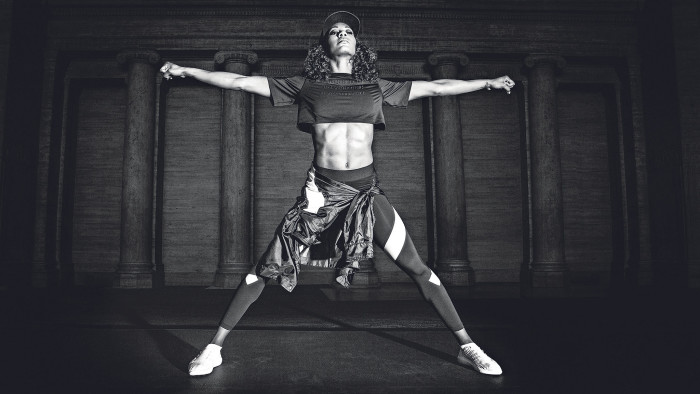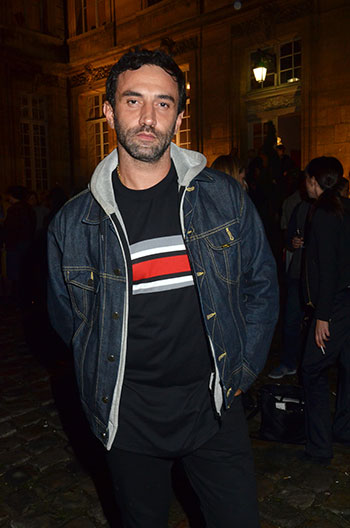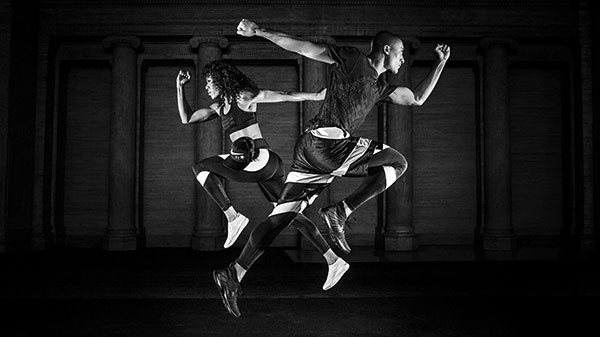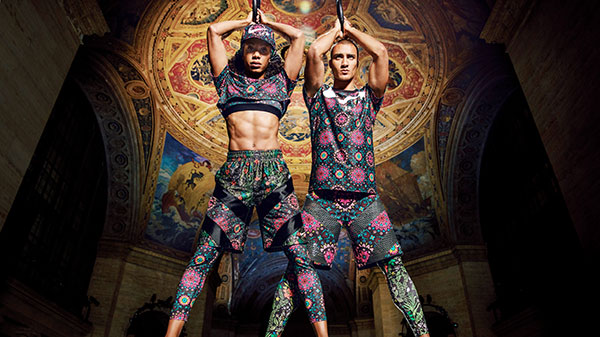Nike’s new moves

Simply sign up to the Life & Arts myFT Digest -- delivered directly to your inbox.
“My lawyer, she’s 55. She’s super chic and she wears classic clothes and Nike on her feet.” Riccardo Tisci, the 41-year-old Italian creative director of the LVMH-owned couture house Givenchy, is talking about the realities of how we wear clothing today. Last week, he unveiled his first collection of performance sportswear with Nike. The collaboration, which will launch in July to coincide with the Rio Olympics, says much about the unstoppable rise of sports clothing, as well as changes in the fashion industry, as designers wrest more control and navigate the new waters of an increasingly post-seasonal system. Of working with Nike, Tisci says: “It makes me feel more complete.”
The collection, which has the official title “NikeLab x RT: Training Redefined”, is small but precise. Each piece is built for functionality and performance, which for Tisci meant a complete switch in his design process. “Usually I do volumes, I do patterns, then I apply the fabrics,” he says. “This was the other way round. I started with the fabrics and finished with volume.” Pieces will retail between £30 and £180.
The giant sportswear brand (which had revenues in 2015 of $30.6bn) is increasingly focusing on fashion collaborations to maximise new streams of revenue. (Revenues for the entire LVMH group were €35.66bn.) While figures released by Nike for the quarter ending February 29 showed an 8 per cent increase in revenues to $8.03bn, these fell below expectations.
In ready-to-wear fashion, sportswear tends to be an interpretation of the sporty codes rather than anything that might be worn for track and field. Here, functionality was the key motivation. “I discovered a lot,” says Tisci. “A lot of the pieces are not sewn together, they are bonded or glued. Each gram, each extra bit of weight you eliminate in a garment allows the body to perform better.”
Tisci has already collaborated with Nike on special editions of the Dunk and Air Force 1 sneakers, both times adapting an existing design. This collection is the first time he has created wholly new work for Nike. “The shapes are all brand new,” he says. “They’re all Riccardo Tisci shapes. The purpose was to bring a new volume, a new concept to the sports industry, but respecting the functionality and performance of Nike.”

The range plays with fabric, branding and how garments are worn during and after sport. Pieces have panels of what Tisci calls “fishnet”, but which is actually a performance mesh. Waistbands of basketball shorts have branding on the inside to be revealed when folded over. There’s also a skirt. “I wanted to think of the arrival and departure from doing sport,” he says. “Women always want to cover their legs by putting a jumper round their waist. I said, ‘Why not do a skirt that you can take off easily, do your sport, then put it on again?’”
The first part of the collection will be black and white. The second will feature a vivid camouflage print of flowers and skulls. The flowers come from Oregon, the home of Nike; Taranto, Tisci’s Italian home town; and Brazil, a country for which Tisci has a deep affinity. His 1.2m Instagram followers were lately treated to his many posts and videos of the Rio carnival. “I spend two or three months a year in Brazil,” he says. “I didn’t want to do Brazil in the obvious way. A lot of people are going to do that related to the Olympics. I know the real Brazil, the streets and the favelas, the love of the body, of sports, of movement.”
Although it involved new skillsets, Tisci found designing the collection relatively easy. “As a creative person, I’m a train,” he says. “I’m don’t takes days and days. I designed it in a weekend. I know what will make Nike happy, and myself. It’s rare that I change from sketch to reality. One of my strengths is that I’m fast and I know what I want.”

Tisci is a prime example of the global generation now entering middle age who grew up with sportswear as a natural part of their wardrobes. “I come from a poor area outside Milan,” he says. “I did a lot of sports when I was young, because sport for me was something where I didn’t have to pay.” He excelled at basketball, until leg problems aged 14 stopped him taking part.
The designer recognised the aesthetic appeal of sportswear as a young adult. “The video of ‘Manchild’ by Neneh Cherry was the explosion of my love of sportswear,” he remembers. “I used to go to clubs wearing Nike shoes with oversized New York Yankees jumpers. It was my first approach to sportswear outside of sport.”

Nike Air Force 1 sneakers were among his first fashion buys. “It was Nike Air Force 1 high-tops, Helmut Lang jeans and a Versus shirt. Those were my first fashion items,” he says. In London, where he studied fashion at Central Saint Martins, he discovered the boundaries between streetwear and high fashion further disappeared. “Being at Central Saint Martins helped me to break things down, and to understand that even if things were strange or different, they could be fashion,” he says.
Tisci’s interest in leisurewear has always been fundamental to his design. He was a relative unknown when he became creative director of Givenchy in 2005, at a time when the house was creatively and financially stagnant. “At the beginning, everyone was shocked that I brought so much sportswear to couture,” he says of the sweatshirting, sneakers and T-shirts that have become his house codes. “Then it became a trend. But I don’t see it as a trend. I see it as a natural part of my style.”
The sportier elements of his design have done much to contribute to the label’s change in fortunes, but how do his Givenchy bosses feel about him working with Nike? “They’re fine,” he says. “At Givenchy, we’re not doing sportswear. It’s fashion. It’s a luxury house, a couture house. They’re happy to see me happy.”
Tisci is proud of his work at Givenchy but he clearly sees himself as working beyond the house’s bounds. He describes the brand as “a client” and recently was the creative director of a video for Anohni, formerly Antony Hegarty. Like many creatives, Tisci’s interests stretch beyond pure fashion.
“I think fashion needs to modernise,” he says. “In the past two decades, we’ve been stuck on the same way to produce, to present. These new changes are very important: fewer seasons, individuality, buy-now-wear-now. I think people want the clothes right away. We need a new way to deliver and present it. It’s time.”
Many have cast the current shifts in the catwalk system as a crisis. “The only crisis is when people are insecure,” he says. “When you are insecure, you stop looking at your own identity, and you look at the identity of other people and what they sell best. It doesn’t mean another person’s bestseller is going to be your bestseller. If you have a strong identity, people will be faithful and come back to you.”
This collection for Nike is all about his own identity. Will there be more? “If this one is successful in the way we think it will be, there’s more to come.”
And so Tisci continues to evolve as a thoroughly 21st-century designer. This past season, sportswear collections have infiltrated the fashion system more than ever. On his Instagram feed, Tisci has posted positively about “Fenty”, the first collection by the pop star Rihanna for Puma, and “Yeezy”, the third collection by “my one and only brother” Kanye West for Adidas.
West developed his “Yeezy” line with Nike but subsequently took the name, and designs, to Adidas. West has been vocal about his dislike of the sports behemoth: “Nike, Nike treat employees just like slaves”, go the lyrics of “Facts” on his latest album The Life of Pablo.
Did Tisci discuss his Nike partnership with West? “I prefer not to answer about Kanye,” he says. “He’s my friend and we have a private relationship. Because he works with a competitor, it’s better that we keep it . . . me and Kanye have a special relationship. I think it should stay like that.” And so it stays.
Comments